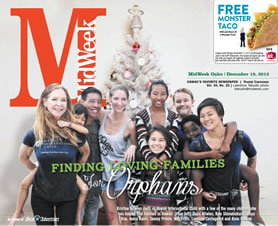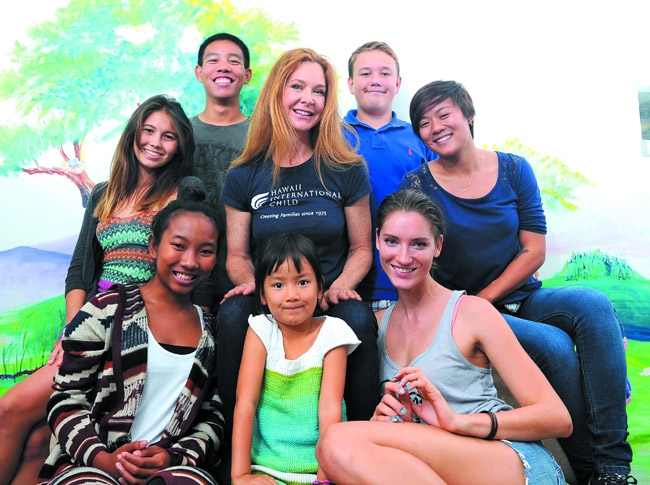Finding Loving Families For Orphans
With 150 million orphan children awaiting adoption worldwide, says Kristine Altwies of Hawaii International Child, there’s no shortage of opportunities for families to adopt
The recent Sandy Beach birthing incident had Hawaii residents transfixed with shock, sympathy, horror. Perhaps the sentiment was for the helpless, unwanted baby or the frightened, un-ready mother. Perhaps it was a general feeling of dismay that one of life’s most important family moments, one that is normally associated with warmth, love and tenderness, could be so cold and full of disconnect.
mw-mwcover-121812-adoption-1
One lonely child at a time, one yearning family at a time, Hawaii International Child is on a mission to bring more warmth into the world not just locally, but globally.
“We wish she had known about agencies such as ours,” notes HIC CEO and executive director Kristine Altwies. “If a woman is pregnant and unable to care for her child, we’ll work with her during the pregnancy and then place the child.”
Domestically, HIC helps pair barren families with pregnant mothers unprepared for raising a child. But with the staggering figure of 150 million orphans waiting in adoption systems the world over, HIC also is kept busy matching waiting international children with Hawaii families ready to give them a permanent home.
“Our current focus is on older children, up to age 15, because they are the ones who are more apparently in need at this point,” says Altwies.
For the child’s best interest and the sake of the parents-to-be, the background of the child is carefully reviewed, and prospective parents are required to go through a clearance and training process.
Criteria set up by the U.S. government for foreign adoptions are that the child has 1) two deceased parents, 2) one living parent incapable of caring for the child, 3) living parents who officially have turned over the child to the state, or 4) been removed from the parents by the state because of abuse or neglect.
“Parents go through a stringent vetting and assessment process before they’re accepted into any adoption program,” stresses Altwies. “Very rarely do parents not pass. The process is to encourage reflection and preparation, which then results in solid families and good parenting.”
Major changes are afoot since Altwies joined HIC in 1991. Origin countries and length of time it takes for prospective parents to finalize an intercountry adoption are constantly in flux. When Altwies first came on board, HIC was adopting mostly from former Soviet countries and Korea. Disharmonious incidents and bloated media attention over these rare cases occasionally alter the field, and sometimes, as with Russia, Altwies says she was no longer comfortable with the relationship with officials or lack of information being provided about the children.
Over the past 20-plus years, she’s helped bring in little bundles of joy from Azerbaijan, the Philippines, Thailand, the Ukraine and many more countries. Lately, at an average of 25 to 35 adoptions a year, Altwies has been focusing on China, pilot programs in Uganda and West Africa, and smaller programs in Taiwan and Japan. Repeatedly charmed by so many of the children she has come in contact with over the years, in 2009 Altwies decided to open her own home to a child, adding to her family of two stepchildren and a birth child.
“I adopted with two other friends,” she says. “The three of us went to China and adopted girls who are the same age, from the same orphanage, and we’re trying to raise them together to the extent possible.”
That experience of traveling to the child’s country of origin is important, says Altwies, for the purpose of “better understanding who the child is and where the child comes from literally and figuratively.” With the focus in mind of smoothing the child’s transition and providing a sense of continuity between their former and new life, HIC hosts monthly country-specific playgroups. Children from Vietnam might gather one month and others from Kazakhstan the next. The largest gathering is the annual Chinese New Year celebration open to all adoptive families.
Another happens at Christmas time.
“In the winter holidays, we have a trolley that goes and sees the city lights,” says Altwies, “and we have a party here at the office.”
Gone is the milieu of shame and secrecy that once blanketed any reference to adoption. In fact, HIC is all about celebrating adoption.
“We encourage all parents to tell their children they’re adopted, even if the child looks just like the family and no one would ever know,” points out Altwies. “It’s the only honest, ethical and loving way to approach adoption. Secrets lead to shame and confusion. We encourage our parents to talk about adoption from the beginning, even before the child has the intellectual capacity to understand the word. By putting the word adoption in connection with that child’s identity, when the child is old enough to understand the concept, there won’t be a disconnect or paradigm shift because the word is already part of who he or she is.”
Laying the groundwork for productive inter-country relationships means Altwies and COO Kristine Castagnaro often find themselves in foreign lands. Every 10 to 12 weeks, Altwies is either in Africa or China, relying on her capable staff to keep Hawaii operations functioning optimally.
“The agency is all about the dedicated staff who work long hours for minimal pay,” she says. “And they only do it because we have incredible clients. Every client who comes in is an inspiration to us. Without their willingness to go down this road with us, we wouldn’t be able to do the work we do, which is for the sake of the children, and it’s so rewarding.”
The cost over the couple of years it takes for all the paperwork and immigration red tape to settle about equals the cost of going through fertility treatments, says Altwies. HIC sees many repeat adoptions, where couples take on a second or third child, sometimes adopting two children at once. Though first-time parents often, understandably, seek a younger, “healthier” child, according to Altwies, HIC’s current focus is on families ready to take in children with medically correctable conditions. She refers to a photo of three boys from China, ages 3 to 6, with varying treatable conditions. Despite any hardships, their smiles leap right off the page.
“I urge people who think they can’t adopt or who think they will never be parents to at least pick up the phone and call,” says Altwies, “because having briefly been in a position where I didn’t think I was going to be a parent, I know the pain. Anyone who wants to be a parent should at least investigate before closing that door.”
Hawaii International Child offers a range of services from surrogacy to embryo and egg matching for couples who wish to carry a child in pregnancy, and from local and international adoption to vast resources for prospective or current adoptive parents.
There’s one small (ahem) glitch that arose just before this article went to print. HIC, which has provided loving forever homes for thousands of international children over the years, is ironically about to lose its own home. The city bought the building, which happens to be directly in the path of the planned rail system. HIC now has six months to find new headquarters.
For more information, or to open your own heart and resources to HIC itself or to make a difference for that one waiting child half a world away, visit adoptionhawaii.org.







